1/350 USS Flasher (SS-249)
|
KIT #: |
? |
|
PRICE: |
4800 yen SRP for Yankee Modelworks kit and 2800 yen SRP for the
AFV Club kit. Less at HLJ. |
|
DECALS: |
? |
|
REVIEWER: |
Tom Cleaver |
|
NOTES: |
Combination of
two kits |
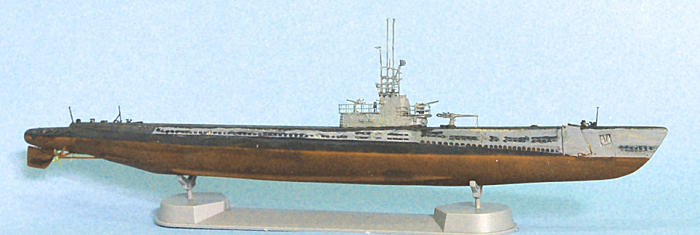
The Fleet Submarine was developed to scout ahead of the
fleet and report on the enemy fleet, then attack the enemy in preparation for
the main fleet action, which would be a titanic gun battle between battleships.
Effectiveness in this role required a submarine to have high surface speed, long
range and endurance, and heavy armament. The state‑of‑the‑art in submarine
design and construction between the wars made this combination of qualities
difficult to achieve.
By 1931, the experimental phase of fleet submarine
development was completed and the Navy made solid progress toward what would
eventually be the Gato‑class. By 1940, the
Tambor and
Gar class submarines provided the right combination of
factors and the long desired fleet submarine was a fact.
The Gato class,
which first appeared in 1941 and provided the majority of
U.S.
submarines that operated during the Second World War was the ultimate
development of this concept, with the subsequent Balao
class differing primarily in equipment as a result of combat experience.
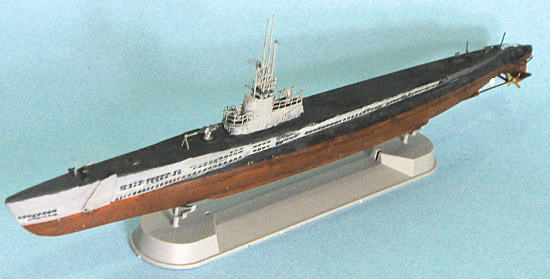 However, the “fleet boats” would seldom ever operate in
this role, outside of their participation in the
Battle
of Midway, and the First and Second Battles of the
Philippine Sea.
With the offensive power of the
U.S.
Pacific Fleet dealt the blow of
Pearl Harbor,
the submarine force became the major offensive weapon available and were loosed
as commerce raiders from the beginning.
“Execute Unrestricted Submarine Warfare Against
Japan”
was the first order issued after the Japanese attack on
Pearl Harbor.
However, the “fleet boats” would seldom ever operate in
this role, outside of their participation in the
Battle
of Midway, and the First and Second Battles of the
Philippine Sea.
With the offensive power of the
U.S.
Pacific Fleet dealt the blow of
Pearl Harbor,
the submarine force became the major offensive weapon available and were loosed
as commerce raiders from the beginning.
“Execute Unrestricted Submarine Warfare Against
Japan”
was the first order issued after the Japanese attack on
Pearl Harbor.
The Gato class
differed from the preceding Tambor and
Gar class submarines by an
increase of five feet in length added to the engine room section to allow the
addition of a watertight bulkhead to divide the one large engine room in two,
with two diesels in each. They were slow divers compared to some German and
British designs, due to the fact they were significantly larger, but their size
allowed them to carry sufficient fuel and supplies for a 75 day patrol from
Hawaii to Japan and back. At the outset of war, a Gato
could submerge in 45-50 seconds, with the delay coming from a “hang” as the
superstructure flooded.
Over the course of the war, additional limber holes were
cut in the superstructure, and by 1943 a well-trained crew could go from surface
to periscope depth in 30-35 seconds.
The Gato class
all had air conditioning, refrigerated storage for food, fresh water distilling
units, clothes washers, and bunks for nearly every crew member.
A British submarine captain who brought his T-class
submarine into
Fremantle,
Australia
in 1944, found himself amazed at such luxuries, which were virtually unheard of
in other navies. Operating in the tropics, these “luxuries” contributed to the
habitability of these submarines, which were anything but “pig boats.”
Air conditioning operating as a dehumidifier was crucial
in the tropics, where the heat of recently shut-down engines, electronic gear,
and 70 bodies could quickly raise internal temperatures to 100F, with high
humidity condensing to cause electrical shorts and fires.
The Gato class
proved to be the most successful combat submarines ever used, sinking 6 million
of the 7 million tons of commercial ships in the Japanese Merchant Marine and
effectively cutting Japan off from the benefits of its imperial conquests, as
well as sinking numerous Japanese warships, including
Shinano, the largest aircraft carrier of the war.
They were so successful that the United States Navy
intervened at the Nuremberg War Crimes Trials to prevent the trial of German
U-boat commander Karl Donitz for the crime of operating German submarines as
unrestricted commerce raiders, lest the U.S. Navy be held guilty of the same
charge.
USS Flasher:
The most successful
U.S.
submarine of the Second World War, USS Flasher
received three Presidential Unit Citations and six battle stars, sinking 21
ships for a total of 100,231 tons.
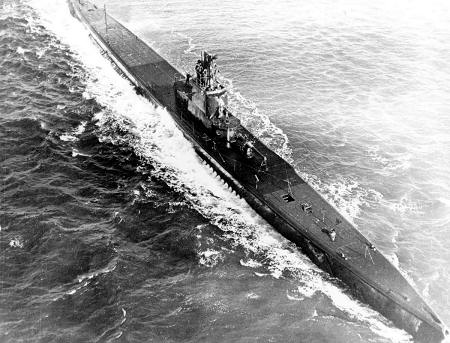 Flasher was built at Electric
Boat Co. in
Groton,
Connecticut,
with her keel laid down
September 30, 1942;
she was launched
June 20, 1943.
She arrived at
Pearl Harbor
on
December 15, 1943
and sailed on her first war patrol on
January 6, 1944,
headed for an area off
Mindoro.
Her first ship, a 2,900 ton former gunboat, was sunk on
January 18.
She intercepted a convoy outside
Manila
on
February 5, 1944,
and sank a freighter, sinking two more ships from the same convoy on February 14
before heading for
Fremantle,
Australia.
One of the two freighters was the
Hokuan Maru, which probably rammed and sank the
Grayling on September 9, 1943.
Flasher was built at Electric
Boat Co. in
Groton,
Connecticut,
with her keel laid down
September 30, 1942;
she was launched
June 20, 1943.
She arrived at
Pearl Harbor
on
December 15, 1943
and sailed on her first war patrol on
January 6, 1944,
headed for an area off
Mindoro.
Her first ship, a 2,900 ton former gunboat, was sunk on
January 18.
She intercepted a convoy outside
Manila
on
February 5, 1944,
and sank a freighter, sinking two more ships from the same convoy on February 14
before heading for
Fremantle,
Australia.
One of the two freighters was the
Hokuan Maru, which probably rammed and sank the
Grayling on September 9, 1943.
Her second war patrol took Flasher
to the coast of
French Indochina
in April 1944, where she sank a gunboat and freighter on April 29, following
that with a large cargo ship in the
Sulu Sea
on May 3.
On her third war patrol in the
South China Sea,
Flasher made found a heavily-escorted
convoy of 13 ships on
June 28, 1944.
Shortly after
midnight
on June 29, she broke into the convoy on a night surface action and sank a
freighter, badly damaging a large passenger cargo ship. On July 7, she sank a
freighter.
On July 19, she sighted the light cruiser Oi, escorted by a
destroyer.
In two attacks during which she was heavily depth-charged by the
destroyer, she sank the cruiser, then sank two tankers on July 26.
Torpedoes expended, she returned to Fremantle.
The fourth war patrol to the
Philippines
saw Flasher head an attack group with
two other submarines, Hawkbill and
Becuna. Flasher operated as a lifeguard
during air attacks preliminary to the invasion of the Philippines, but still
managed to sink three ships before returning to Fremantle at the end of October,
1944.
On her fifth war patrol Flasher again headed the same
attack group, bound for Cam Ranh Bay,
Indochina.
On December 4, Hawkbill
found a tanker convoy and the wolf pack assembled. Approaching the convoy in a
heavy downpour, a destroyer suddenly appeared out of the murk;
Flasher stopped the destroyer with two hits, then
hit a tanker before bing forced to dive by a second destroyer.
After being depth-charged, Flasher
returned to periscope depth and found the burning tanker, covered by a third
destroyer.
Though nearly blinded by rain squalls,
Flasher fired four torpedoes, two of which sank the
destroyer and two of which ran deeper past the destroyer to hit the tanker
before bei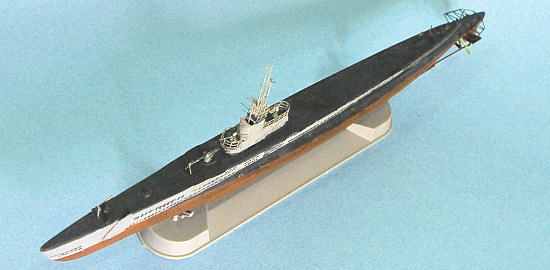 ng
forced deep again by escorts.
Surfacing shortly after sunset,
Flasher finally sank the tanker, which had finally been
abandoned. The two destroyers were found after the war to have been sunk.
ng
forced deep again by escorts.
Surfacing shortly after sunset,
Flasher finally sank the tanker, which had finally been
abandoned. The two destroyers were found after the war to have been sunk.
Flasher found another
well‑guarded tanker convoy on
December 21, 1944,
and began a long chase, finally getting into position to attack from the
unguarded shoreward side. In rapid succession, she sank three of the tankers -
one of which was the largest ship she sank in the war - receiving no
counter‑attack since the enemy apparently believed they were in a minefield.
After refitting at Fremantle,
Flasher made her sixth war patrol, again to the coast of
Indochina,
in February. Contacts were few, but she sank a sea truck by surface gunfire on
February 25, 1945,
and sank a cargo ship on February 29 with torpedoes. She arrived at
Pearl
Harbor
on April
3, 1945,
and left April 7 for a West Coast overhaul.
She did not return to combat before the end of the war.
Flasher was retired in 1947 and
stricken from the naval list in 1963, shortly before the launching of a second
USS Flasher,
SSN-613.
Her conning tower and deck gun were saved and form the
centerpiece of the Submarine Memorial that honors the 52 U.S. submarines and
crews lost during the war at the submarine base in Groton, Connecticut.
The second USS Flasher,
the thirteenth submarine of the Permit
class of nuclear-powered attack submarines, was equally as successful, receiving
five battle efficiency E’s, four Meritorious Unit Commendations, a Navy Unit
Commendation, and a Presidential Unit Citation - all for operations that remain
classified - during her 25-year career.
She was decommissioned in 1991 and her hull was
destroyed in 1994.
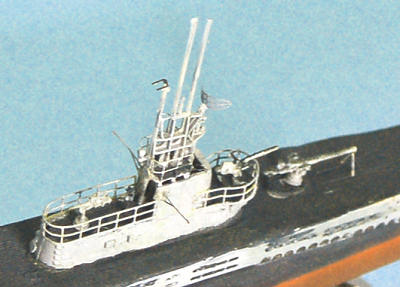 I was really looking forward to building the “1943 Gato
class” release from
AFV
Club, since this would be the classic World War II fleet boat.
Imagine my surprise to discover that the upper hull part
was for the Guppy 1A release, which is completely inaccurate for a World War II
fleet boat!
Anyone else ordering this kit may be equally disappointed if
AFV
Club managed to release all the kits with this mistake.
This is really unfortunate, since the other
AFV
Club Gato submarines are very accurate
models.
I was really looking forward to building the “1943 Gato
class” release from
AFV
Club, since this would be the classic World War II fleet boat.
Imagine my surprise to discover that the upper hull part
was for the Guppy 1A release, which is completely inaccurate for a World War II
fleet boat!
Anyone else ordering this kit may be equally disappointed if
AFV
Club managed to release all the kits with this mistake.
This is really unfortunate, since the other
AFV
Club Gato submarines are very accurate
models.
Outside of the solution I outline below, the only way I
can see getting an accurate late war fleet boat from an
AFV
Club kit would be to buy this kit and either the 1941 or 1942 Gato kits, which
do have the accurate upper hulls.
What to do?
Well, necessity being the mother of invention, I decided
I could scratchbuild an appropriate conning tower to turn most of the
AFV
kit into a Guppy 1A boat, but that left the really nice conning tower, as well
as the really good gun armament, which includes a 20mm and 40 mm cannon, as well
as a 4-inch deck gun.
Fortunately, I had a Yankee Model Works resin Gato boat
that had been languishing in its box due to the outline inaccuracy of the hull,
the poor mold of the conning tower, the awful gun suite, the poor photoetch
detail, and the mold block that ran nearly the whole length of the lower hull.
 I cut away the mold block with my Big-A$$ razor saw,
sanded everything down, and corrected the profile outline of the hull. The
forward superstructure is really too narrow, but it was “close enough” to
proceed.
I also cut off the poor conning tower.
I cut away the mold block with my Big-A$$ razor saw,
sanded everything down, and corrected the profile outline of the hull. The
forward superstructure is really too narrow, but it was “close enough” to
proceed.
I also cut off the poor conning tower.
All the left-over parts from the
AFV
Club kit were used for this model, which resulted in an acceptable late war
fleet boat.
I made the fore and aft diving planes and rudder from sheet
styrene to replace the too-thin photoetch parts from the resin kit, and made the
prop shafts from Evergreen rod.
I did use the photoetch props.
The photoetch prop guards from the
AFV
Club kit were used.
I also used the photoetch conning tower railing from the
Yankee Modelworks kit, with the photoetch detail railing for the upper sail from
the
AFV
Club kit.
I airbrushed the lower hull with Tamiya “Hull Red,” then
airbrushed the upper hull and superstructure with Tamiya “NATO Black”.
I hand-painted the Haze Grey using a mixture done from
Xtracrylix paints, which allowed me to dry-brush the areas around the limber
holes, so they can be seen, while looking appropriately worn from being at sea.
I
attached the weapons in position as Flasher looked in late 1944 with the 40mm
weapon in the forward conning tower position and the 20mm aft, with the 4-inch
deck gun forward.
I really wish
AFV
Club had not screwed the pooch so badly on this release, since I could easily
see myself doing a couple more of these.
If that ever gets straightened out, I will get at least
one more.
In the meantime, I now have two famous US fleet boats in the
collection: Wahoo and
Flasher.
This project is proof that you can indeed make two
lemons into lemonade.
Tom Cleaver
April 2011
AFV
Club and Yankee Modelworks kits courtesy
HobbyLink Japan.
If you would like your product reviewed fairly and quickly, please
contact
me or see other details in the
Note to
Contributors.
Back to the Main Page
Back to the Review
Index Page


 However, the “fleet boats” would seldom ever operate in
this role, outside of their participation in the
However, the “fleet boats” would seldom ever operate in
this role, outside of their participation in the  Flasher was built at Electric
Boat Co. in
Flasher was built at Electric
Boat Co. in  ng
forced deep again by escorts.
Surfacing shortly after sunset,
Flasher finally sank the tanker, which had finally been
abandoned. The two destroyers were found after the war to have been sunk.
ng
forced deep again by escorts.
Surfacing shortly after sunset,
Flasher finally sank the tanker, which had finally been
abandoned. The two destroyers were found after the war to have been sunk.

 I cut away the mold block with my Big-A$$ razor saw,
sanded everything down, and corrected the profile outline of the hull. The
forward superstructure is really too narrow, but it was “close enough” to
proceed.
I also cut off the poor conning tower.
I cut away the mold block with my Big-A$$ razor saw,
sanded everything down, and corrected the profile outline of the hull. The
forward superstructure is really too narrow, but it was “close enough” to
proceed.
I also cut off the poor conning tower.